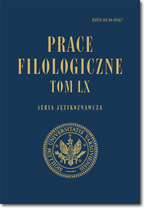Co właściwie spójniki łączą? Powrót do pytań zasadniczych
Just what objects do conjunctions link? The fundamental questions revisitated
Author(s): Jadwiga WajszczukSubject(s): Language and Literature Studies
Published by: Wydział Polonistyki Uniwersytetu Warszawskiego
Keywords: składnia zdania; włączniki; przyimiki; spójniki; partykuły; structure of sentence; structure of utterance; syntactic lexemes; vs quasisyntactic (para-syntactic) lexemes; includers; prepositions vs. conjunctions; particles
Summary/Abstract: From the traditional point of view conjunctions are thought of as linking devices, i.e. syntactic operators. However, the so-called “linking function” has not been clearly defined. It also refers to prepositions, whose properties are quite different: it is prepositions which, unlike “conjunctions”, are true syntactic operators. Another circumstance worth mentioning is the fact that the term “conjunction” refers to a heterogeneous class of words. The author introduces a set of criteria for classification of lexemes that allows us to identify a homogeneous class of conjunctions without a recourse to the notion of “linking function” (they are neither active nor passive valency terms, they open unmarked positions for linguistic items, i.e. words, word groups, clauses or sentences). Conjunctions are functioning exclusively outside the sentence syntax; they are not syntactic operators. They perform the function of meta-operators, i.e. they organize (as is also the case with particles) the functional structure of utterances in its complicated thematic-rhematic constellations as well as express comments on the members there of. Two subsystems of Polish conjunctions proper are distinguished: (1) {i, oraz, tudzież, a, lub, albo, bądź, czy, ni, ani}; (2) {czyli, to, jakoż, toteż, lecz, ale, gdyż, bo, albowiem}.
Journal: Prace Filologiczne
- Issue Year: 2011
- Issue No: 60
- Page Range: 263-286
- Page Count: 24
- Language: Polish

